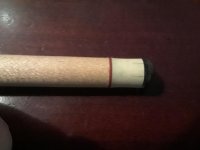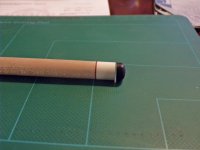You are using an out of date browser. It may not display this or other websites correctly.
You should upgrade or use an alternative browser.
You should upgrade or use an alternative browser.
G-core ferrule replacement
- Thread starter 3railout
- Start date
I have a G-core shaft with a cracked ferrule. With the way the guy chalks the cue he has worn the shaft behind the ferrule. Can I put a longer ferrule on or do I need to replace it with the same length?
My opinion is to send it back to McDermott if he is the original owner. Companies like McDermott want to know what went wrong and figure out why.
BUT, have to ask.....How does the customer's chalking habit change the dia. behind the ferrule? My 20 + years of repairs/building says someone sanding a shaft aggressively when either repairing a dent, or doing a cleaning is usually the culprit for a smaller dia. of the shaft compared to the ferrule. The other only normal cause is the ferrule material expanding due to using it as a breaker, or the guy just hits too damn hard on every shot.
If you measure the height of a cube of chalk, then measure the length of a ferrule on a G core shaft....one will realize...it isn't possible to damage the shaft behind it without more to the story.
JMHO,
Dave
My opinion is to send it back to McDermott if he is the original owner. Companies like McDermott want to know what went wrong and figure out why.
BUT, have to ask.....How does the customer's chalking habit change the dia. behind the ferrule? My 20 + years of repairs/building says someone sanding a shaft aggressively when either repairing a dent, or doing a cleaning is usually the culprit for a smaller dia. of the shaft compared to the ferrule. The other only normal cause is the ferrule material expanding due to using it as a breaker, or the guy just hits too damn hard on every shot.
If you measure the height of a cube of chalk, then measure the length of a ferrule on a G core shaft....one will realize...it isn't possible to damage the shaft behind it without more to the story.
JMHO,
Dave
I've seen chalk grooves from bad chalking. If the cube of chalk has a deep hole and you chalk the tip with the bottom of the hole with a rocking motion as you twist it can happen. With a really short ferrule, it can happen on the shaft portion.
There is both improper chalking that wore the groove in the ferrule, and some sanding/cleaning/wear that rather slightly reduced the shaft diameter below the ferrule. When you install and turn the new ferrule down, turn just 4 or 5 thou off the transition area between the shaft and the ferrule to get rid of that small peak and everything should flush up fine.
Something else to consider is ferrule material for the replacement.
As best I can tell,Juma is original. At least it's still readily available. Tommy D.
I cannot find where juma was used by McDermott on the G-core shafts. It is very white compared to juma, and when machined, had different characteristics then juma. Don't know what they use, but it seems pretty much stronger than juma.
Dave
The damage to the ferrule looks like either bad chalking, or bad shaping practices. The shaft side looks like someone sanded it lower than the red pad. 2 separate issues. Again, As I mentioned earlier, measure a piece of chalk and then the length of ferrule.....it's a stretch, IMO.So I'm pretty sure this is caused by improper chalking. I'm posting a pic, it's as clear as I can get it. I think I'm going to put a original sized ferrule and just turn the whole thing uniform.
Thanks for the feedback, great info.
I wouldn't use juma as a replacement, as it is not the same as what the original was. Tomahawk or isoplast would my choices. Tomahawk being white as like the original would be the first choice. Whatever you use needs to be a strong material, as it is a thinner wall when finished.
Dave
If you don’t mind me asking, I was curious as to the internal construction of the shaft around the tip area. McDermott states this shaft has carbon fiber through the front of the shaft, but does the carbon fiber also act as a tenon for the ferrule? Also, is the carbon fiber hollowed out, or filled with wood like the Pic on the McDermott website states? I think I’m getting a McDermott with a g-core shaft soon.
Sent from my iPhone using Tapatalk
Sent from my iPhone using Tapatalk

